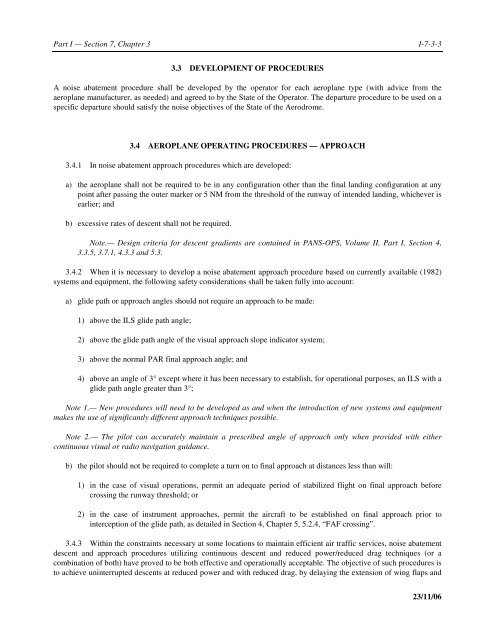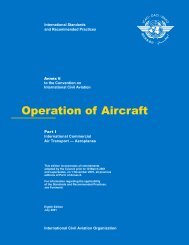Aircraft Operations
Doc 8168 Aircraft Operations, Volume I Flight Procedures
Doc 8168 Aircraft Operations, Volume I Flight Procedures
- No tags were found...
You also want an ePaper? Increase the reach of your titles
YUMPU automatically turns print PDFs into web optimized ePapers that Google loves.
Part I — Section 7, Chapter 3<br />
I-7-3-3<br />
3.3 DEVELOPMENT OF PROCEDURES<br />
A noise abatement procedure shall be developed by the operator for each aeroplane type (with advice from the<br />
aeroplane manufacturer, as needed) and agreed to by the State of the Operator. The departure procedure to be used on a<br />
specific departure should satisfy the noise objectives of the State of the Aerodrome.<br />
3.4 AEROPLANE OPERATING PROCEDURES — APPROACH<br />
3.4.1 In noise abatement approach procedures which are developed:<br />
a) the aeroplane shall not be required to be in any configuration other than the final landing configuration at any<br />
point after passing the outer marker or 5 NM from the threshold of the runway of intended landing, whichever is<br />
earlier; and<br />
b) excessive rates of descent shall not be required.<br />
Note.— Design criteria for descent gradients are contained in PANS-OPS, Volume II, Part I, Section 4,<br />
3.3.5, 3.7.1, 4.3.3 and 5.3.<br />
3.4.2 When it is necessary to develop a noise abatement approach procedure based on currently available (1982)<br />
systems and equipment, the following safety considerations shall be taken fully into account:<br />
a) glide path or approach angles should not require an approach to be made:<br />
1) above the ILS glide path angle;<br />
2) above the glide path angle of the visual approach slope indicator system;<br />
3) above the normal PAR final approach angle; and<br />
4) above an angle of 3° except where it has been necessary to establish, for operational purposes, an ILS with a<br />
glide path angle greater than 3°;<br />
Note 1.— New procedures will need to be developed as and when the introduction of new systems and equipment<br />
makes the use of significantly different approach techniques possible.<br />
Note 2.— The pilot can accurately maintain a prescribed angle of approach only when provided with either<br />
continuous visual or radio navigation guidance.<br />
b) the pilot should not be required to complete a turn on to final approach at distances less than will:<br />
1) in the case of visual operations, permit an adequate period of stabilized flight on final approach before<br />
crossing the runway threshold; or<br />
2) in the case of instrument approaches, permit the aircraft to be established on final approach prior to<br />
interception of the glide path, as detailed in Section 4, Chapter 5, 5.2.4, “FAF crossing”.<br />
3.4.3 Within the constraints necessary at some locations to maintain efficient air traffic services, noise abatement<br />
descent and approach procedures utilizing continuous descent and reduced power/reduced drag techniques (or a<br />
combination of both) have proved to be both effective and operationally acceptable. The objective of such procedures is<br />
to achieve uninterrupted descents at reduced power and with reduced drag, by delaying the extension of wing flaps and<br />
23/11/06












